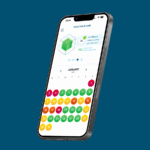Enhancing medication adherence with patient engagement software
- Patient engagement softwares are digital tool to enhance patient-provider communication, deliver health information, and improve patient participation in care decisions1 for a better care-satisfaction and enhanced adherence.
- Choosing the right patient engagement software not just requires careful deliberation of all the salient features, but also consideration of integration capabilities, ensuring data security, regulatory compliance, and user experience2.
- Continuous training and robust technical support are imperative to foster the adoption of patient engagement software in a healthcare organization and improve patient care3.
Patient engagement entails empowering patients and enabling their active participation in healthcare decision-making4. Engaged patients show better treatment adherence, improved patient outcomes, and reduced healthcare costs2. To learn more about patient engagement, please read – Enhancing patient engagement in healthcare – a paradigm shift for improved outcomes.
Although patient engagement is the need of the hour, it is labor intensive. It can be extremely challenging to fit into the busy schedule of healthcare professionals, henceforth necessitating appropriate technological support. Patient engagement software is a digital tool that enables providers to automate engagement with patients in their care journey. This allows providers to proactively reach out to patients at high risk of medication non-compliance, substantially reducing the risk of disease recurrence and hospital readmissions as well as driving better adherence to the care plans2.
Patient Engagement Software: The Backbone of Patient Engagement
Patient engagement software is a digital tool that,1
- Allows providers to communicate with patients
- Manage the physician-patient relationship
- Offers educational resources to the patients
The term patient engagement software is often used interchangeably with patient engagement platform and patient engagement portal. While there is some overlap in their functionality, there are subtle differences between these terms:
- Patient engagement platform: These are digital health applications designed to automate patient outreach and support patients in their healthcare journey.
- Platforms can be used in the form of websites (patient portals), mobile applications, or messaging chatbots. They can be accessed through a range of devices, including smartphones, tablets, and computers
- Patient engagement platforms serve as digital facilitators, automating various tasks such as delivering health education, issuing treatment reminders, assessing pain and mobility levels, managing wound documentation, and tracking and recording health outcomes. 2
- Patient engagement portal: Patient portals are secure online websites sponsored by a provider or health system that provide patients access to selected data contained within their Electronic Health Records (EHRs).
- Patients can access these portals by creating an account and logging in through a secure authentication process with a unique username and password.
- These portals offer patients the capability to peruse various categories of information, including recent appointment records, laboratory and test results, forthcoming appointment schedules, educational resources, healthcare provider notes, billing particulars, and discharge instructions.
- Certain patient portals also facilitate secure communication channels through which patients can message their healthcare providers, request medication refills, and schedule appointments2.
For example, NHS (National Health Service), in the United Kingdom offers a patient engagement software called NHS App5 for patients to access their medical records, appointment booking, and prescription management as well as a patient engagement platform called – My Health Call, that integrates the NHS app and other digital solutions such as virtual wards, patient initiated follow up (PIFU), waiting list validation, and remote monitoring6.
The Role of Patient Engagement Technology in Medication Non-Adherence.
Medication non-adherence is a global healthcare challenge impacting disease outcomes and causing a significant economic burden on the system. For more on medication non-adherence please read our article “What is medication compliance”.
Patients’ misconceptions about their health condition, forgetfulness, socioeconomic status, cultural and religious beliefs as well as poor communication with physicians significantly impact adherence to therapies7.
Digital patient engagement platforms enable medical providers and healthcare systems to offer their patients ease of access, self-service, and convenience, which can enhance patient engagement and self-management1. Some of the basic tenants of the patient engagement technology that could enhance adherence are:
- Reminders and notifications: Patient engagement software provides automated reminders and notifications to patients, ensuring they take their medications on time.
- Education and information: Patient engagement software can offer educational resources about the disease and medications to the patients, helping them understand the importance of adhering to their prescribed medication regimens.
- Communication & support: Through secure messaging or telehealth functionalities, patients can reach out to their physician in case of any doubt or concern, encouraging patients to take more active participation in their medication management.
- Tracking & Monitoring: Many patient engagement tools allow individuals to track their medication intake by logging each dose they take. This feature helps patients stay aware of their adherence patterns1.
Patient engagement technology offers great potential to improve the quality of care and enhance outcomes. In a pilot study on patients with depressive disorders, a web-based information and communication technology system reportedly resulted in enhanced medication adherence and improved outcomes8. In another pilot study, a tailored and interactive text message solution increased the medication refill rates in patients with one or more chronic diseases9.
Multiple patient engagement tools are offered at a:care (Abbott) platform that provides information, advice, and practical tips to manage health. Some of the key tools available on the platform are:
- My a: care app: The app features a patient motivational program along with medication reminders. Automated motivational messages encourage the formation of new habits for positive lifestyle changes and enhancing medication adherence. Patients can create personalized treatment plans, receive appointment and prescription renewal reminders, and track their adherence progress through the app. Additionally, the unique “Keep the Cube Green” approach aims to maintain patients’ overall motivation for lifestyle changes, not just related to their medication regimen10.
- a:care Insight: This is a unique feature based on SPUR (Social, Psychological, Usage, and Rational) – an adherence profiling tool. The a:care insight helps in identifying non-adherence in patients through a questionnaire that assesses the rates of medication non-adherence and the potential causes/factors leading to this behavior. It further provides input to HCPs to strategize a personalized engagement with the patients to improve adherence11.
Choosing the right patient engagement platform: What are the criteria?
A digital patient engagement platform should align with the organization’s objectives. The following are some factors that should be considered while deciding2:
- Integration with existing systems: Determine whether the software can seamlessly integrate with the organization’s existing electronic health record (EHR) or practice management software.
- Security & compliance: Verify that the software complies with relevant security and privacy regulations such as Health Insurance Portability and Accountability Act (HIPPA).
- Customisation & Scalability: Consider whether the software can be customized to match the respective organization’s specific needs. Additionally, assess its scalability to accommodate growth and changes in patient volume or services over time.
- Features and functionality: Assess the software’s features and functionality, ensuring it offers the specific capabilities you require.
- Ease of use: Evaluate the software’s user interface. It should be easy for both the patients and healthcare providers to navigate and use the software effectively.
- Mobile Support: Check if the vendor provides a mobile application. The mobile app functionality allows patients to access the software while on the go, fostering improved engagement with physicians2.
- Technical support and training: Assess the technical support and training services offered by the software vendor. Strong support and comprehensive training resources can ensure a seamless implementation process and continued effective utilization of the software3.
The Next Step: Strategize the implementation.
Cultivating the right environment is essential for successfully implementing technology in an organization. Enterprises should focus on:
- User training: Training both the patients as well as the hospital staff is important for the successful implementation of the patient engagement software. Hospital leadership should collaborate with system developers to create policies to guide user training and seamless integration of portals into clinical workflows3.
- Organization-wide deployment: Implementing the technology uniformly across the organization streamlines data sharing across the care continuum. This aligns both the provider and the patient in one direction, encouraging their engagement with the platform12,13 .
- Guidelines & frameworks: Setting up best practices for data sharing and creating standardized evaluation frameworks and measures are essential for a smooth patient portal3,12 implementation
- Technical support: Offering technical support such as a dedicated help desk, IT assistance, or user guides fosters staff confidence and encourages their active participation in using the technology3.
To maximize the effectiveness of the deployed patient engagement technology:
- Target the right user. Identify the patient segment that is either capable of using the technology or willing to adopt it3.
- Try including family members to support and encourage the patients14.
- Consider linking financial incentives to increase the usage and adoption of the technology by the patients15.
Medication non-adherence: Patient Engagement Software hits the right spot.Engaging patients in their healthcare plays a crucial role in addressing medication non-adherence. By leveraging patient engagement technology, healthcare providers can promote health education, provide personalized support, send customized reminders, and enhance patient-provider communication. However, the adoption of patient engagement platforms by healthcare providers remains quite low1,2. Therefore, hospitals must prioritize positive staff attitudes toward patient portals. This can be achieved by implementing effective staff training and providing robust technical support. Additionally, hospitals should involve staff in the design of the patient portals, ensuring that the technology meets their needs and integrates smoothly into existing workflows3.
“When you add other things such as chat or a little bit of augmented intelligence, you could provide far more than an initial connection to your digital front door, but also help with patient education, compliance and save money through efficiencies and processes”
– Diane Weber, R.N., B.S.N., M.H.A., Executive Director, SHSMD, American Hospital Association.













